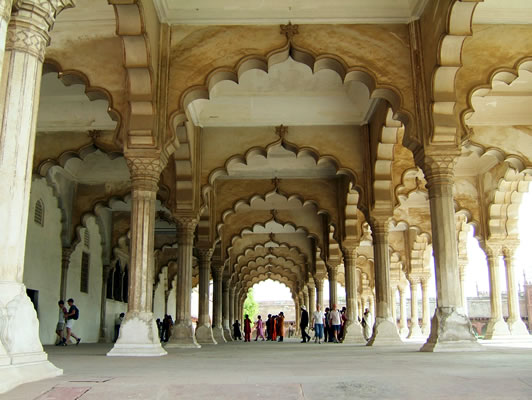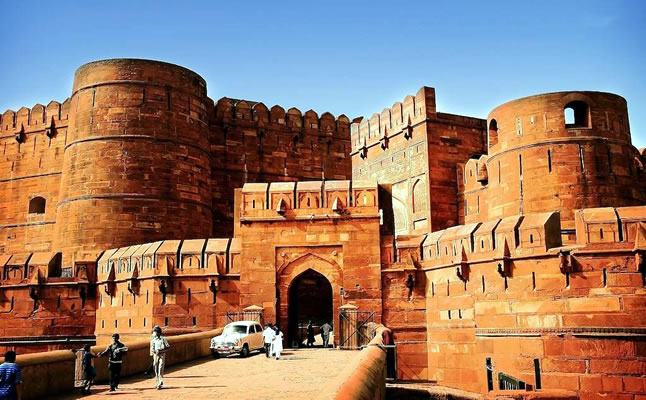The Kanch Mahal
(1605-19)
Hindi Version | View Gallery |
|
[Not a valid template]It is situated at a little distance, on the eastern side of the main (southern) gateway of Akbar’s Tomb at Sikandara. Originally surrrounded by a garden, with the usual causeways, water-courses and tanks, it was a harem quarter, a ‘mahal’ or ‘Ladies Resort’ which was also used as the Royal Shikargah (Hunting-lodge) by Jehangir. It can be assigned to the period from 1605 to 1619. Owing to its situateion on the Agra-Delhi Imperial Highway, it fell an easy prey to the vandalism of the invading armies and rebellious people, and much of this beautiful building, particularly its southern portion facing the road, had been destroyed during the decadent age of the later Mughals. For some time, it was under the Church Missionary Society. Later, it was acquired, restored and conserved by the Department of Archaeology. The building (Plates-122 & 123) was originally a square measuring 53’×53′ (16.5 × 16.15 m). Externally and internally, it is a two-storeyed mansion, planned around a covered, central square hall ‘A’, 16′ (4.88m) side. It is not open to sky, and is roofed by a valued soffit which bore traces of painting. Plinths of ‘B’ and ‘C’ dalans on the eastern and western sides of the central hall ‘A’ have been considerably raised. Range of octagonal doublepillars rest on this plinth, which thus serves as a pedestal. These pillars support the massive piers of the second storey, the rooms of which open and overlook the central hall, which has thus been worked out as an inner court (angen) in this essentially residential building. [Not a valid template]The hall ‘A’ opened on north and south sides in rectangular central portals ‘D’ and ‘E’. Four square rooms ‘F’, ‘G’, ‘H’ and ‘I’ have been given in the four corners of the plan, each opening on at least two sides for ventilatin, and each one is also connected with the side ‘dalan’ ‘B’ or ‘C’ respectively. Adequately interconnected and ventilated, this was, thus, a beautiful modification of the usual Mughal square plan of nine parts, adopted in domestic architecture. Two stairways, sunk into the S – E and S – W corners, lead above to the second storey (first floor) which has series of halls and rooms corresponding to the ground plan, externally overlooking the compound below through jharokhas (windows) and gaukhs (balconies) which not only make this storey extremely open and airy, but also bestow upon the respective facade a uniformly beautiful impression. They are all interconnected through short narrow passages. Two stairways again lead above to the terrace which too seems to have been over-whelmingly changes. Probably, there originally was an arched jalied saraparda (curtain) of stone on all sides, giving the impression of a third storey. This could have ensured purdah (veil) which was a social need imposed upon architecture. [Not a valid template]Its norther and southern facades were originally identical, each having a broad, deep and magnificant central portal, rising almost to the full height of the building upto the frieze, flanked on either side by a smaller arch on the ground floor opening into the adjoining room, overlooked gorgeously, on the first floor, by a semi-hexagonal jalied jharokha with a semi-hexagonal cupola roof (Plates-124 &125). Only the northern facade has survived intact. The eastern and western sides were also identical, each having on the first floor a pillared gaukh on the norther and southern sides overlooking the arch which also opened into the respective corner room. There thus were four jharokhas, two each on the northern and southern facade, and four gaukhs, two each on the eastern and western side of the palace. The structure was made of brick masonry which was internally plastered over and painted, while it was all finished in finely carved red sandstone externally. The pointed arch or iwan which makes up the central portal of the northern facade measures 23′-9″ (7.24 m) in the height and 16′-9″ (5.11 m) in breadth. It has a broad, elaborately carved intrados which bears a fringe (jhalar) of lotus-buds at the edge, supported on either end by the upturned trunk of couchant elephant, a popular Mughal motif. On its sides are given raised seats or chowkis which was an essential feature of the poli (portal or entrance porch) in domestic architecture of this region. Entrance from the portal into the central hall ‘A’ is given through an oblong stone-framed doorway. Overhanging its is an exquisitely designed adn moulded chhajja, resting on six beautiful brackets which are a typical constituent of the classical art of the Mughals. On it opens, from the first floor, a broad pointed arch, truly in the fashion of a Jharokha, like the one used in the central arch of the Qal’ai- Kuhna Masjid Old Fort, Delhi (c. 1533-40; 1555-65). The surving northern facade has been very tastefully finished. The architect has taken recourse to a system of panelling of the whole mural surface to work out horizontal and vertical zones, each treated independently with a perfect design, fitting coherently and harmoniously in the total scheme. He has, very judiciously, used buff colour sandstone alongwith deep red stone on these panels, in order to prevent colour-monotony which is sometimes as aesthetic snag at Fatehpur Sikri. [Not a valid template]The chief mode of ornamentation he has adopted in this scheme in carving, or the treatment of the mass and volume of stone to create threedimentional effect and a beautiful play of light and shadow which is key to aesthetic appreciation in this tropical region. It is low, medium and high reliefs, all very carefully organized on the mural surface in a wide variety of motifs and designs such as wine-vase (surahi) in sunk, vertical niche (Plate-126); a full-blown lotus having three series of overspreading petals in high relief contained in sunk, eight-cusped, circular niche (Plate-127); graceful stylized arabesques in low relief on the sprandrels; an ornamental form of Shrivatsa contained in horizontal, 16-cupsed cartouche (ornamental frame in bold relief); geometrical and floral designs; typical Muslim chevron on the nook-shafts; and pair of elephants with entwined trunks, in high relief. Some designs have been used, alongwith these compositions in carving, in inlaid mosaic. Glazed-tiling is the other mode of ornamentation which has been used here extremely carefully, on such upper and prominent parts of its architecture as friezes and roofs, for a gorgeous and beautiful effect. Blue, green and orange tiles have been used on the semi-hexagonal supola roofs of the jharokhas. The friezes bear blue and yellow tiles. It is owing to this exterior embellishment with mosaic of glazed-tiles and that palace became famous as Kanch-Mahal (literally, Glass-Palace). The surface decoration of this building is superb and unique and it is one of the most ornately finished buildings of the classical age of the Great Mughals. The total effect of the building, however, is pre-eminently architectural and its does not depend for its beautiful impression upon its ornamentation as the Chini Ka Rauza at Agra does. It is noteworty that, enough it does not have a dome, arch has been so naturally used with such essentially trabeate features of the Jamuna-Chambal region as pillar, bracket, lintel, chhajja, gaukh and jharokha, that the total effect is entirely coherent and harmonious and the composite aspect of its design makes it one of the most representative buildings of the age of Jehangir. This open and airy building was, obviously, conceived as a residential palace and a shikhargah where the Emperor, while ahunting outside the capital, could spend his nights with his womenfolk in perfect comfort and security. Its unique plan later inspired the domestic architecture of the region; gradually, the central hall, which is closed at the Kanch-Mahal, was opened to sky, around the late 17th and early 18th century A.D., admitting profuse light and air into the interior, to make an ‘angan’ (court) in the real sense of the term, and this became the standard plan of the residential house in the Jamuna-Chambal region, numerous examples of which have survivd at Vrindavan, Agra and Gwalior. |




